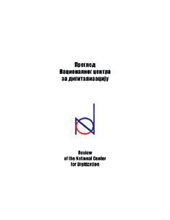Issues
Review of the National Center for Digitization
Publisher: Faculty of Mathematics, University of Belgrade
ISSN: 1820-0109
Issue: 39
Year: 2021

POSITIVE IMPACT OF MIGRATION IN THE FIELD OF EDUCATION
Maja Nikolova
Keywords: education, migration, development, patriarchal environment
One of the most important was the one in World War I when the population and the army passed and on Corfu, and the youngest went to school in France. This migration had a large significant Serbian people. Post-war French influence was present in social life - in politics, science, culture, and education. Knowledge of the French language and the elegance of French hats were not the only features of French students' lives. Their successes in all fields of natural and social sciences testify that the education acquired in French lyceums and colleges, or graduation courses, had a far-reaching impact on their professional life and that they, as such, became symbols of a time and historical events. Thus, Serbia's social history cannot be viewed in a complex way without the influence that French students had on ordinary people's everyday lives or socio-political events in interwar Serbia.
The specificity of migration is, and its impact on the Serbian nation's socio-political and cultural events was education, mostly male children, from Old Serbia's territory in the late 19th and early 20th century. At to space in which was still under Ottoman rule, live Serbs who were under severe historical conditions tried to develop a primary school network. The process of upbringing and education depended on the current political circumstances and the available resources in Serbia and the area of Old Serbia. For high school education, they were forced to go to Serbia, mostly to teacher's schools, or to the Serbian high school in Constantinople and Thessaloniki. Upon their return to their homeland, in addition to the knowledge that was primary, they brought with them new European manners that were difficult and slow to spread in the patriarchal environment.
In the search for national identity and its maintenance, customs, religion, and language were nurtured, and family moral upbringing enabled the survival of people of the Orthodox faith in those areas. Strict family relations in a patriarchal and backward society conditioned the level of education of young people, especially in terms of female children's education. On their return to the old environment, students educated in Serbia or European Turkey influenced its transformation. These changes were visible in education and everyday life - women began to leave the house, hang out, and the cleavage on the blouse became deeper. The changes were also visible in the cultivation of the land, the construction of houses, and the spirit's strength, which slowly began to sink into new trends.
This paper aims to point out the positive impact of population migration in the field of education. For backward patriarchal environment could not develop without external influence, people trained in more developed areas that have acted on them as the immigrant is at a certain time.
1 - 12
DIGITIZATION OF THE JOURNAL "POVELJA 1971–2020"
Vesna Andrijašević and Ivana Hrenko and Ivan Spasojević
Keywords: Povelja, journal, digitization, digital humanities, the Public Library "Stefan Prvovenčani" Kraljevo
13 - 18
PROTECTION OF LIBRARY COLLECTIONS AND READERS DURING THE PANDEMIC PERIOD
Petra Vávrová and Jitka Neoralová and Dana Novotná and Richard Frank Mally
19 - 30
RAILWAY HERITAGE OF BANAT
Zoran Cvetković and Ada Vlajić and Rifat Kulenović
Keywords: Serbian railways, Banat railway history, railway infrastructure, railway heritage
31 - 47
DIGITIZATION OF PUBLICATIONS OF THE ASTRONOMICAL SOCIETY "RUĐER BOŠKOVIĆ"
Žarko Mijajlović and Nadežda Pejović
48 - 56
DIGITAL LEGACY OF PROFESSOR JOVAN SIMOVLJEVIĆ
Nadežda Pejović and Viktor Radović
57 - 63
MONUMENT TO THE LIBERATORS OF NIŠ RELATES TO US THE HISTORY OF THE CITY
Dušan Tatić and Radomir Stanković and Marko Jovanović and Jovan Stojanović and Dušan Andrejević and Nikola Arsić
64 - 73
"COMPUTERS IN YOUR HOME" DIGITAL REBUILD: REVIVING THE START OF THE PERSONAL COMPUTER REVOLUTION IN FORMER YUGOSLAVIA
Dejan Ristanović and Voja Antonić and Darko Staničić and Srđan Simić and Jelica Protić
74 - 82
DIGITALIZATION IN MODERN TRANSPORT OF PASSENGERS AND FREIGHT
Gyula Mester and Jelena Pisarov
Keywords: self-driving car, sensor, data processing, robot taxi, car sharing, public passenger transport, freight transport
83 - 89
AUTOMOTIVE DIGITAL PERCEPTION
Gyula Mester and César Bautista
Keywords: Automotive digital perception, self-driving robotic cars, dynamic environments, sensors, algorithms, actuators.
90 - 95
ACADEMIC RANKING OF WORLD UNIVERSITIES 2021
Gyula Mester and Jelena Pisarov
Keywords: Academic Ranking of World Universities 2021, Higher Education, Institute of Higher Education, Shanghai Jiao Tong University, University of Belgrade, University of Novi Sad, University of Zagreb, University of Ljubljana, Eotvos Lorand University, University of Szeged, Semmelweis University, indicators.
96-101